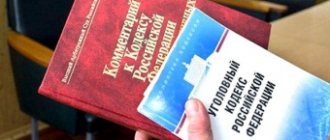Murder is the intentional killing of another person, regardless of his age or health.
Accounting for about 15% of all recorded murders, the analyzed types represent the most dangerous type of murder. Therefore, the Constitution of the Russian Federation allows for the possibility of applying the death penalty for these crimes.
The second part of Article 105 of the Criminal Code of the Russian Federation provides for paragraphs that describe qualified types of murders. They can be grouped according to the elements of the crime.
Typically, elements of a crime are used as classification criteria. With this approach, the types of murders under consideration can be divided into the following:
- Murder, taking into account the characteristics of the object of the crime: two or more persons; a person or his relatives in connection with the performance of official activities by this person or the performance of public duty; a person in a helpless state, known to the perpetrator, and also associated with the abduction or capture of a person; women who are known to the perpetrator to be pregnant.
- Murder, taking into account the characteristics of the objects of the crime: committed with particular cruelty; committed in a generally dangerous manner; committed by a group of persons by prior conspiracy or by an organized group.
- Murder, taking into account the characteristics of the subjective side of the crime: for mercenary reasons or for hire, and even associated with robbery, extortion or banditry; for hooligan reasons; in order to hide another crime or facilitate its commission, as well as involving rape or sexual assault; based on national, racial, religious hatred, enmity or blood feud; for the purpose of using the victim’s organs or tissues.
The proposed scheme is conditional, since it is not difficult to suggest that some types of skilled murders do not completely fit into it.
Each of the murders described in various paragraphs of Article 105 of the Criminal Code of the Russian Federation constitutes an independent crime. If one person commits several murders, this requires the classification of these actions as a set of crimes.
In the legislation of the Russian Federation in 2022, simple and qualified murder are distinguished. Simple is a murder without qualifying and privileged characteristics. Such murders include causing the death of a citizen without aggravating or mitigating circumstances.
The concept of skilled murder
What qualified murder is is described in the second part of Article 105 of the Criminal Code of the Russian Federation. This is murder with aggravating circumstances.
Article 105 lists 26 signs combined into 13 points . The presence of any of them significantly increases the degree of public danger of murder. Some of these signs are clear and do not need explanation.
If there are several aggravating circumstances in the murder committed, then when qualifying the crime there must be references to all paragraphs of part two of Article 105, which provide the corresponding signs.
Punishment is imposed not for each sign separately, but for the second part, since they are not parts and do not have their own sanctions.
Qualified signs of murder can be divided into two groups:
- characterizing the object and objective side of the crime;
- characterizing the subjective side and personality of the criminal.
Signs characterizing the object of a qualified murder
The characteristics of the object and the objective side of a qualified murder come down to the following:
- The specificity of killing two or more persons is the sole intent to take the life of two or more persons. The implementation of such intent in most cases is simultaneous, but a time gap is not excluded. In the first case, the intent to commit murder against one person is necessarily direct. In relation to another, it can be both direct and indirect. In the second case, in relation to both victims, intent can only be direct. It is possible that the murder of one of the victims was not completed due to circumstances beyond the control of the criminal. In this case, attempted murder will be qualified under the first or second part of Article 105 or the third part of Article 30 of the Criminal Code of the Russian Federation. And a completed murder under the second part of Article 105 of the Criminal Code of the Russian Federation. This type of murder should be distinguished from murder committed several times, when there is no single intent to kill two or more persons.
- The murder of a person who is in a helpless state is known to the perpetrator , and is also associated with kidnapping or capture. It is characterized by the helplessness of the victim, who, due to her physical or mental condition, cannot defend herself and resist the criminal. Such persons may be children, the elderly, the seriously ill, persons who are intoxicated and are not able to correctly understand what is happening. In this case, the perpetrator realizes the hopeless situation of the victim.
- The danger of killing a woman who is pregnant , knowingly for the perpetrator, is that not only the woman, but also the unborn child dies. This takes into account the vulnerability of a woman in the later stages of pregnancy. If the perpetrator knows that the victim is pregnant, the duration of the pregnancy does not matter.
- In a murder committed with particular cruelty , such cruelty can be manifested in relation to both the victim herself and other persons. Mocking a corpse cannot be considered particularly cruel. In this case, Article 244 of the Criminal Code of the Russian Federation is applied, which provides for liability for desecration of the bodies of the dead. Murder is recognized as committed in a generally dangerous manner if the perpetrator used a method that, knowingly for the perpetrator, could lead to the death of not only the victim, but also another person.
- Murder is recognized as committed by a group of persons by prior conspiracy or by an organized group if two or more persons jointly acted with intent to commit murder and participated in the use of violence in the process of deprivation of life.
- Repeated murder is the killing of two or more persons when there is no single intent to take their life. In most cases, such crimes are not related to each other and are committed at different times.
Signs that characterize the subjective side of murder:
- The murder of a person or his relatives in connection with the performance of official activities by this person.
- Murder for mercenary reasons for hire, as well as associated with robbery, extortion or banditry.
- Murder for hire is a murder associated with the receipt of any material or other reward. In this case, the person who directly committed the murder is liable under the third paragraph of Part 2 of Article 105 of the Criminal Code, and the person who “hired” him is liable as an instigator under Part 4 of Article 33 and the third paragraph of Part 2 of Article 105 of the Criminal Code.
- Murder for hooligan reasons is associated with clear disrespect for society and generally accepted moral standards.
- Murder with the aim of concealing another crime or facilitating its commission, as well as involving rape or acts of a violent nature, is qualified under the second part of Article 105 of the Criminal Code of the Russian Federation, if the perpetrator had no other motive for the murder.
- Murder motivated by national, racial, religious hatred or enmity or blood feud. It is dangerous because the criminal intentions of the perpetrator extend to an indefinite circle of people, each of whom has not done anything bad to him.
- Murder for the purpose of using the victim's organs or tissues. In this case, the subject of the crime can be either a medical worker or any other person.
Kinds
According to the Criminal Code of the Russian Federation, the following types of murders are considered:
- A crime that was committed taking into account the characteristics of the subject - this can include cases with a pregnant woman, a crime in which the injured party is a person with limited liability.
- A crime that was committed taking into account the characteristics of the subjective side - this can include murders committed from hooligan motives, or in order to hide another, previously committed offense.
- A crime committed taking into account the characteristics of the objective side - the deprivation of a person’s life with particular cruelty, committed by a group of people, and so on.
As for the qualified elements of murder, they are characterized using objective signs.
Criminal legal characteristics of murder
Criminal liability arises taking into account the objective and subjective circumstances of the commission of qualified murder.
The purpose of criminal liability, as in other cases, is to restore justice, correct the convicted person, and achieve prevention of a particular and general nature.
The criminal law characteristic of qualified murder, which is provided for in Part 2 of Article 105 of the Criminal Code of the Russian Federation, is murder committed in the case of aggravating circumstances.
Committing crimes by any of the methods specified in the second part of Article 105 of the Criminal Code is punishable by imprisonment for a term of 8 to 20 years or life imprisonment. When assigning punishment for such a crime, a differentiated approach and clarification of all the circumstances of the case are necessary.
No one can be found guilty or subject to criminal liability without a court decision in accordance with current legislation.
The most difficult thing in criminal practice is related to murder, in which several points of Part 2 of Article 105 are present.
Thus, qualified murder is a crime that is committed under aggravating circumstances. The object of the crime is human life.
Criminal liability arises if there is a connection between the action and the resulting harm.
The definition of this crime is contained in the second part of Article 105 of the Criminal Code of the Russian Federation. The presence of any of the signs of murder that are indicated there significantly increases the level of public danger of such a crime.
The Criminal Code states that simple murder is punishable by imprisonment for 6–15 years, and an additional suspended sentence of 24 months may be imposed.
If we are talking about a qualified crime, you will have to pay for it for a period of 8 to 20 years and receive a restriction of freedom for a maximum of 2 years. If there is a murder of exceptional gravity, the sentence may be lifelong.
Basic issues of qualification of various types of murders under the criminal legislation of the Russian Federation
The fundamentals of the Russian Constitution, as well as most international legal acts, proclaim human life as the highest good, and, accordingly, an object of protection. Russian criminal law, in accordance with the Constitutional provisions, focuses on life as an object of criminal legal protection, in particular, by the fact that the Special Part of the Criminal Code of the Russian Federation begins with a chapter that combines crimes against the person, against life and health, in addition, the most severe punishment in The death penalty and life imprisonment are provided only for committing crimes related to an attempt on life. The main and most serious crime against life is murder, and this act in Russian criminal law and in legal doctrine, depending on various criteria, is divided into types, including simple, privileged and qualified murder. A whole series of criminal legislation, united in Chapter. 16 of the Criminal Code of the Russian Federation is dedicated to establishing the elements of various types of murders, so, in Part 1 of Art. 105 of the Criminal Code of the Russian Federation establishes the elements of simple murder, pp. “a”, “b”, “c”, “d”, “d”, “e”, “e.1”, “g”, “h”, “i”, “j”, “l”, "m" part 2 art. 105 of the Criminal Code of the Russian Federation - provide for the elements of crimes - qualified murder and Art. 106–108 of the Criminal Code of the Russian Federation, provide for elements of privileged murder. One of the important differences between privileged and qualified, as well as simple murders, is the category of the crime - the first named type belongs to the category of crimes of moderate gravity, while simple and qualified ones belong to especially serious ones.
From the point of view of the dynamics of the crimes under consideration in Russia, their quantitative indicator also differs depending on the type - according to the Judicial Department of the Supreme Court of the Russian Federation based on the results of the first half of 2022, throughout Russia, under Part 1 of Art. 105 of the Criminal Code of the Russian Federation, 3,213 people were convicted on various counts of Part 2 of Art. 105 of the Criminal Code of the Russian Federation, 807 people were convicted, under Art. 106 of the Criminal Code of the Russian Federation, 17 people were convicted under Art. 107 of the Criminal Code of the Russian Federation, 45 people were convicted, under Art. 108 of the Criminal Code of the Russian Federation, 129 people were convicted, which is a total of 9.2% of the number of those convicted for crimes against life and health (45,413). Judicial practice cannot do without acquittals against persons accused of various types of murder, the number of which during the above period reached a total of 16, which is 6.7% of the total number of acquittals for crimes against life and health (Chapter 16 of the Criminal Code of the Russian Federation). [7] The data presented, among other things, indicate obstacles that arise in the process of law enforcement, the main of which, of course, are problematic qualification issues. According to the author, the main reason for the obstacles that arise in the classification of both murder and any other crime is the insufficient legislative regulation or elaboration of the corpus delicti, which is essentially a universal formula, as well as the lack of legal interpretation by the Supreme Court of the relevant norms of criminal law and individual cases of their application , which entails the absence in judicial practice of a unified approach to resolving this or that issue, which therefore remains open to theorists of criminal law and practical workers of investigative and judicial structures. As stated above, legislation and the theory of criminal law know different types of murders; accordingly, each type of murder has its own specific qualifications and the obstacles that arise. Thus, the author highlights the issues of qualification of simple murder, qualified and privileged murder, but this division is given with a degree of convention, since the question of qualification that arises in the legal assessment of one act (for example, Article 106 of the Criminal Code of the Russian Federation) is not related to the composition of another murder, albeit also privileged (for example, Article 108 of the Criminal Code of the Russian Federation). Having analyzed the opinions of scientists and judicial practice, it seems necessary to pay attention to the following main issues of qualification of various types of murders.
Simple murder (Part 1 of Article 105 of the Criminal Code of the Russian Federation). Regarding the qualification of an act in accordance with the specified composition, the most difficult issue is establishing the subjective side of the composition, while other signs in practice are usually not difficult to establish and confirm. The subjective side of the crime under Part 1 of Art. 105 of the Criminal Code of the Russian Federation is the only sign by which this act can be distinguished from the crime provided for in Part 4 of Art. 111 of the Criminal Code of the Russian Federation, as well as an essential feature that distinguishes simple murder from acts of moderate gravity and serious, resulting in the death of the victim through negligence (for example, Article 109, Part 2 of Article 143, Part 2 of Article 216, paragraph “c” Part 2 of Article 238, Part 2 of Article 293 of the Criminal Code of the Russian Federation, etc.). In addition, the issue of establishing the subjective side is of enormous importance when qualifying this act using Part 3 of Art. 30 of the Criminal Code of the Russian Federation, that is, as an attempt. Actions aimed at causing death (including gestures, words), and not completed due to circumstances beyond the control of the perpetrator, depending on the direction of intent, can be qualified under Art. 119 of the Criminal Code of the Russian Federation (threat of murder), the sanction of which provides for a maximum penalty of two years in prison and qualified punishment - in the form of five years in prison, or under Part 3 of Art. 30, part 1 art. 105 of the Criminal Code of the Russian Federation, the sanction of which provides for punishment exclusively in the form of imprisonment for a term of six to fifteen years. Taking into account the peculiarities of criminal proceedings regulated by the Criminal Code of the Russian Federation [2] and the Code of Criminal Procedure of the Russian Federation [3], for crimes of various categories of severity, the difference is obvious.
Qualified murder (items “a”, “b”, “c”, “d”, “d”, “e”, “e.1”, “g”, “h”, “i”, “ j", "l", "m" part 2 of article 105 of the Criminal Code of the Russian Federation). Five of the thirteen elements of qualified murder are due to the fact that they are associated with the commission of another crime, for example, kidnapping, robbery, extortion, or was the purpose of concealing another crime. Accordingly, in the process of establishing correspondence between the signs of an act and the signs of the corresponding composition, the law enforcement officer must establish and give a criminal legal assessment of the predicate crime, without which the composition provided for in the relevant paragraph of Part 2 of Art. 105 of the Criminal Code of the Russian Federation. In addition, in judicial investigative practice, questions often arise when qualifying an act under paragraph “c” of Part 2 of Art. 105 of the Criminal Code of the Russian Federation on the basis of the helplessness of the victim, and despite the existing explanation of the Supreme Court of the Russian Federation, some cases continue to cause difficulty in understanding and consolidating the state of helplessness of the victim at the time of the commission of the crime. According to the author, this issue can and should be clarified not through legal interpretation, but through rule-making - introducing a legislative definition of the concept of a helpless state. We also note that a number of elements of qualified murder provide for an optional element in the form of a motive (for example, paragraphs “e.1”, “l”, Part 2 of Article 105 of the Criminal Code of the Russian Federation), which must be identified with the act as a mandatory condition for imputing the corresponding element , however, due to the absence, for example, of a legislative definition of the concept of “blood feud,” establishing such a motive may be difficult.
Privileged murder (Articles 106, 107, 108 of the Criminal Code of the Russian Federation). Taking into account the peculiarities inherent in each specific composition of privileged murder, judicial investigative practice also faces some problems also inherent in the qualification of a particular act. For example, the corpus delicti under Art. 106 of the Criminal Code of the Russian Federation provides for a special subject - the mother of a newborn child, while at the legislative level there is no definition of the concept of “mother”, as is known, parental and, accordingly, maternal rights from the point of view of law can be enjoyed not only by the woman who directly carried and gave birth to the child (for example , in surrogacy, the legal mother is the woman who owns the egg that formed the zygote of the gestated embryo). It is also worth noting the issue of difficulty in qualifying the act associated with the murder of two or more newborns by a mother during a multiple pregnancy, on which there is no both the point of view of the legislator and the explanation of the highest judicial body. RF. The difficulties of qualifying the act provided for in Art. 108 of the Criminal Code of the Russian Federation [4,6], in particular the issue of murder when exceeding the limits of necessary defense. The authors point out the evaluative nature of the concept and the absence of legislatively established signs of a clear discrepancy between the protection and the nature and degree of danger of the attack, which is associated with the main difficulties in applying this norm of criminal law.
Thus, given that numerous questions that arise in the process of qualifying various types of murders still remain unanswered, the relevance of studying this problem and ways to solve it is beyond doubt. As part of the research work, the author will attempt to study and clarify such ways of resolving qualification issues as legal interpretation and the formation of a unified approach in judicial practice, as well as rule-making that allows eliminating gaps in criminal legislation, clarifying it where required, and Specific measures have also been proposed that can influence the increase in the efficiency of government bodies whose purpose is to protect the rights and freedoms of man and citizen, as well as fair justice.
Literature:
- Constitution of the Russian Federation of December 12, 1993: as amended as of July 21, 2014 // Collection of Legislation of the Russian Federation. 2014. No. 17.
- Criminal Code of the Russian Federation dated June 13, 1996 No. 63-FZ (current version with amendments and additional amendments entered into force on July 29, 2018) // Collection of legislation of the Russian Federation. 1996. No. 25.
- Criminal Procedure Code of the Russian Federation of December 18, 2001 N 174-FZ (current version with amendments and additions, entered into force on July 29, 2018) // Russian newspaper. 2001. No. 2861.
- Volosyuk E. A., Ivanov S. A. The category “free will” and its role in criminal law // Current problems of modern science V international scientific and practical conference (Moscow, February 2017) - M., 2022, P. 120
- Savelyev I. I. Exceeding the limits of necessary defense // International scientific journal “Symbol of Science” No. 5, 2016. P. 170–172
- Electronic resource: https://www.cdep.ru/ [access date 01/11/2019]









